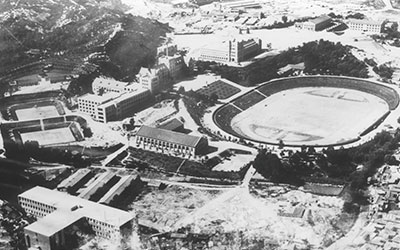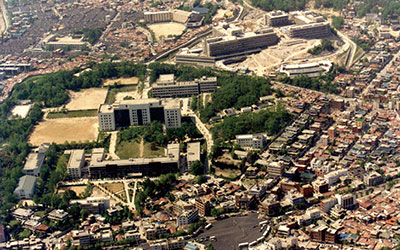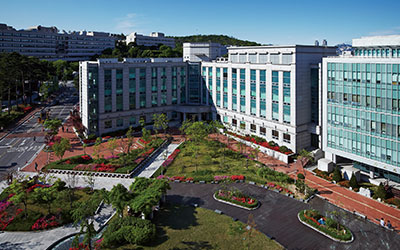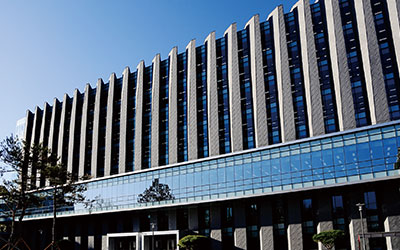1905
Bosung College places an advertisement in the Hwangsung Daily on March 22 to open student registration.
Bosung College, the predecessor of Korea University, is known to start with the Department of Plutology and the Department of Law, but the advertisement shows that the Department of Agriculture and the Department of Industry were also included.
1951
The establishment of the Department of Agriculture is authorized.
The Sciences Campus was established, marking the start of a new phase of agricultural and natural science development in South Korea.
1952.09
The College of Liberal Arts is reorganized as the College of Liberal Arts and Sciences
(composed of the Department of Mathematical Physics, the Department of Chemistry, and the Department of Biology)
1953
The first students in the Department of Agriculture and the Department of Mathematical Physics are admitted.
1955
Three laboratory buildings on the Department of Science, the center of the College of Science, are built on land now occupied by the Communication Building.
1956
The building of the College of Agriculture and Forestry is built (it is now occupied by the College of Education).
1957
The Department of Science has its first graduating class.

▴1958 Chemistry lab
1960
The Science Hall is completed.
The Science Hall was built next to the labs of the Department of Science (which are now used as the Communication Building). The Science Hall, equipped with the latest experiment equipment, provided more learning space for KU students. In 1968, the Department of Science switched its location with the Department of Liberal Arts. As a result, this building became the Liberal Arts Hall. In 2002, it was demolished.

1961
An aerial view of the Korea University Campus
The Science Hall and the labs of the Department of Science are on the left of the Main Hall. The Department of Agriculture is on the opposite side of the Main Hall.
1963
The College of Liberal Arts and Sciences is divided into two colleges: the College of Science and Engineering and the College of Liberal Arts.
“On the Occasion of the Establishment of the College of Science and Engineering” in the March 14, 1964 issue of The Korea University News (approved by the Ministry of Culture and Education in December 1963)
1963.12
The Department of Engineering, the Department of Civil Engineering, and the Department of Architectural Engineering are established.
1964
The Main Building of the College of Science and Engineering (College of Engineering Building #2) is completed.
The Main Building of the College of Science and Engineering, initially designed to be occupied by the College of Medicine, began construction in 1957. However, the completion was delayed due to several reasons. In March of 1964, the building was finally completed. The eastern part of the building was occupied by the Department of Liberal Arts and the western part by the Department of Engineering.
1964
The Foundation Board of Directors develops a five-year plan to expand the facilities of the College of Science and Engineering and the Korea University Farm and allocates a budget of 75 million won.
1965
The first students of the Department of Mechanical Engineering are admitted.
1967
Korea University receives USD 200,000, part of the compensation for the damages caused by Japanese colonialism paid by Japan to South Korea. The funds are first allocated to science and engineering.
1971
The Woosuk University Foundation is merged with the Korea University Foundation, and the Woosuk University College Medicine is renamed the Korea University College of Medicine.
1973
The government of West Germany decides to award a grant to the Korea University College of Agriculture.
The Department of Agriculture became equipped with the latest laboratory equipment and new facilities.
1976
Dr. Ho-Wang Lee discovers the Hantaan Virus.
1976.10
The completion ceremony for the new building for the College of Agriculture on the Sciences Campus is held.
1977.12
The College of Science and Engineering is divided into two colleges: the College of Science and the College of Engineering.
1983
The Science and Engineering Library is established.
The Sciences Campus started developing in the 1960s, much later than the Humanities Campus. Central air conditioning systems and six elevators were installed in the Science and Engineering Library, a library dedicated to science and engineering. The new library building also provided more rooms and amenities for students on the Sciences Campus.

1990
An aerial view of the Sciences Campus
The College of Engineering Building #2, the Science and Engineering Library, and the new building of the Department of Agriculture made up the Sciences Campus. The building of the College of Medicine and the Green Campus were under construction. Aegineung is flanked by the Science and Engineering Library to the north and the College of Engineering Building #2 to the south.
1991
The College of Medicine and Korea University Hospital are relocated to the Green Campus in Anam-dong.
The College of Medicine moved to the Green Campus, marking a landmark moment in the development of the Sciences Campus.
1993
The Seoul Branch of the Korea Basic Science Institute is founded and the building of the Basic Science Hall is completed.
1993.03
The road test of a driverless vehicle with a guidance system is performed for the first time in South Korea.
1996
The building of the Techno-Complex, South Korea’s first industry-academic cooperation complex, is completed.
Industry-academic cooperation is usually carried out in the form of human resources exchanges, commissioned education, students and professors’ field trips to companies and plants, and consignment research projects. The Techno-Complex is the country’s first on-campus center dedicated to industry-academic cooperation.
The College of Engineering conducts research in partnership with businesses and research centers in one place, maximizing the efficiency of technology development through joint research projects, technology information sharing, and exchanges of researchers and equipment between academia and industry
1996.10
The College of Science Asan Hall is completed.
The College of Sciences Asan Hall (Asan is the penname of Ju-yung Chung, the late founder and chairman of Hyundai Group) became the home to the College of Engineering and College of Science, providing KU’s science and engineering students with better learning and research environments. The College of Sciences Asan Hall and the Techno-Complex are the landmarks of the Sciences Campus.

1999
The team of KU College of Engineering wins the RoboCup.
2000
A team of KU researchers develops South Korea’s first walking guidance system (Open Eyes) for the blind.
2000.05
The building of the College of Life Sciences is completed.
2003
The College of Life Sciences, the cradle of high-caliber talents in the field of biotechnology in the 21st century, is established.
The School of Life Sciences (composed of the Department of Biology, the Department of Food Engineering, and the Department of Genetic Engineering) was renamed the College of Life Sciences. In addition, in 2006, the college was merged with the College of Life Science & Biotechnology in order to strengthen its competitiveness.
2003.08
The Innovation Building of the College of Engineering is completed.

2003.08
The new building of the College of Life Science & Biotechnology is completed.
2004
Sung-ho Cho, honorary professor of the Department of Physics, receives a National Academy of Sciences Award.
2005
The groundbreaking ceremony for the construction of Aegineung Square is held.
2006.09
The Hana Square (formerly known as Aegineung Square) is completed.
After the success of the Central Square, KU went ahead with the construction of Hana Square on the Sciences Campus. In order to maximize efficient use of space, parking lots are located on the second and third basement floors. The first basement accommodates lecture rooms, reading rooms, a multi-purpose atrium, a bookstore, a gym, a fast food restaurant, a café, a convenience store and other amenities for KU students. The central lounge has a grand piano for anyone to play.
2007
The Engineering Education Information Center (EEIC) is established.
2008
The CJ Food Safety Research Building and the International Center for Converging Technology Building are completed.
2009.10
The KU Holdings is established.
2011
The Robot Convergence Building and the Woojung Information & Communication Building are completed.
2012.06
All disciplines in the College of Engineering enter the Top 100 QS World University Rankings for the first time in the college’s history.
2013.03
The KU-KIST School is established.
To realize the convergence of theory, experiment, and practice
2014
The IBS Molecule Spectroscopy and Dynamics Group is established.
2014.03
The College of Informatics is established.

2014.12
The Hana Science Hall is completed.
2015.03
The College of Health Sciences is relocated from Jeongneung to the Hana Science Hall on the Science Campus.
To create better interdisciplinary research environments
2015.03
The Research Planning Headquarters is established.
To create researcher-friendly research environments that meet the different planning and support needs of each researcher
2015.09
The “KU-MAGIC,” a biomedical research and commercialization project, is launched.
2016.05
The East Asia-Nordic/Benelux University Consortium (ENUC) is established.
2016
Korea University earns the highest income ever from technology transfer royalties.
The value of orders for large-scale research projects received by KU increased rapidly, and the annual order growth rate increased by 140%.

2016.12
The new Engineering Hall is completed.
2017.03
Korea University ranks 66th in the QS World University Rankings in Engineering and Technology.
KU ranked 66th along with Columbia University, an Ivy League school, and higher than Yale and Penn State. Most notably, it ranked 43rd in Chemical Engineering.
2017.06
Korea University Medical Center is selected as the leader of the Precision Medicine Project, a National Strategic Project.
2017.09
The construction of the Advanced Convergence Medical Center begins.
2018.03
Korea University ranks 48th in the QS World University Rankings in Engineering and Technology, entering the Top 50 for the first time in its history.
KU’s Mechanical & Aeronautical Engineering, Chemical Engineering, Computer Science, and Civil & Structural Engineering were ranked 1st among South Korea’s comprehensive private universities in the employer reputation area.



